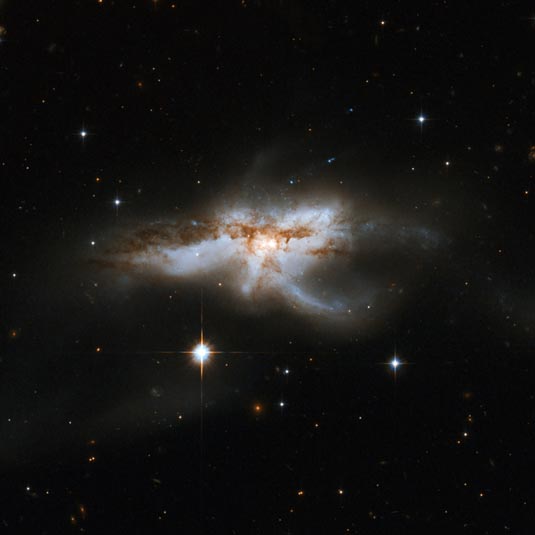
Interacting Galaxies
RA 16h 52m 59.10s Dec. +02 24 02.6
Ophiuchus
350 million light-years (100 million parsecs)
ACS/WFC
February 10, 2002
33 minutes
F435W (B) and F814W (I)
NASA, ESA, the Hubble Heritage-ESA/Hubble Collaboration, and A. Evans (U of Virginia, Charlottesville/NRAO/Stony Brook University)
April 24, 2008
2008 Image 2009 Image 2015 image
ABOUT THIS IMAGE:
NGC 6240 is a peculiar, butterfly- or lobster-shaped galaxy consisting of two smaller merging galaxies. It lies in the constellation of Ophiuchus, the Serpent Holder, some 400 million light-years away. Observations with NASA s Chandra X-ray Observatory have disclosed two giant black holes, about 3,000 light-years apart, which will drift toward one another and eventually merge together into a larger black hole. The merging process, which began about 30 million years ago, triggered dramatic star formation and sparked numerous supernova explosions. The merger will be complete in some tens to hundreds of millions of years.
This image is part of a large collection of 59 images of merging galaxies taken by the Hubble Space Telescope and released on the occasion of its 18th anniversary on 24th April 2008
From
Wikipedia:
NGC
6240 is a well-studied nearby ultraluminous infrared galaxy (ULIRG) in
the constellation Ophiuchus. The galaxy is the remnant of a merger between
two smaller galaxies. The collision between the two progenitor galaxies
has resulted in a single larger galaxy with two distinct nuclei and a
highly disturbed structure, including faint extensions and loops.
The power sources of ULIRGs in general has been greatly debated. Infrared
light from galaxies generally originates from dust in the interstellar
medium. ULIRGs are notable in that they are abnormally bright in the infrared.
The infrared dust emission in ULIRGs is over one trillion times more luminous
than the Sun (i.e. it has an infrared luminosity of 1012 L?). Astronomers
have speculated that either intense star formation regions or active galactic
nuclei (which contain supermassive black holes) may be responsible for
the intense dust heating that produces this emission, although the general
consensus is that both may be present in most ULIRGs. Studying the exact
nature of ULIRGs has been difficult, however, because the dust in the
centers of these galaxies obscures both visible and near-infrared starlight
and because theoretical models of both starbursts and active galactic
nuclei have demonstrated that they may look similar. Because NGC 6240
is a nearby example of such a ULIRG, astronomers have studied it intensively
to understand its power source.